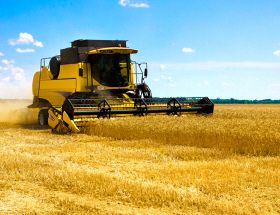 vest will likely be late again this year, particularly in the northern half of the state, write Pierce Paul and Laura Lindsey, The Ohio State University.
vest will likely be late again this year, particularly in the northern half of the state, write Pierce Paul and Laura Lindsey, The Ohio State University.The crop is now turning and drying down, but will not be ready for harvest in some fields until the second or third week of July.
A slow, gradual maturation of the crop could mean excellent yield and grain quality due to extended grain-fill. However, this could also mean more time for late-season diseases such as leaf rust and Stagonoapora glume blotch to develop, as well as problems associated with delayed harvest.
In most areas, disease levels were low during pollination and early grain-fill. So, yields are indeed likely to be high this year, but we may see considerable variation in grain quality from one field to another.
Test weight (grain weight per unit volume or grain density) is the grain quality trait that is most likely to vary among fields, depending on late-season disease levels and weather conditions after maturation and before harvest. Low test weights usually occur if grain is prevented from filling completely or maturing and drying naturally in the field.
Both leaf rust and Stagonospora glume blotch developed after pollination in some fields, and this could have prevented the grain from filling completely, causing a reduction in test weight. Rewetting of grain in the field after maturity but prior to harvest is another factor that could reduce test weight.
When grain is rewetted, the germination process begins, causing photosynthates (i.e., starch) to be digested. This leaves small voids inside the grain which decreases test weight. Additionally, grain will swell each time it is rewetted and may not return to its original size as it dries which will also reduce test weight. Thus the enlarge kernels will take more space but weigh the same, allowing fewer kernels to pack in the measuring container, lowering the test weight.
Pre-harvest rainfall may also affect grain quality. Rain and harvest delay may lead to pre-harvest sprouting in some varieties. Sprouting is characterized by the swelling of kernels, splitting of seed coats, and germination of seeds (emergence of roots and shoots) within the wheat heads.
Some varieties are more tolerant to sprouting than other, and for a given variety, sprouting may vary from one field to another depending on the duration of warm, wet conditions. Sprouting affects grain quality (test weight). Once moisture is taken up by mature grain, stored reserves (sugars especially) are converted and used up for germination, which leads to reduced test weights.
Even before visual signs of sprouting are evident, sugars are converted and grain quality is reduced. Since varieties differ in their ability to take up water, their drying rate, the rate at which sugars are used up, and embryo dormancy (resistance to germination), grain quality reduction will vary from one variety to another.
In addition to sprouting, the growth of mold is another problem that may result from rain-related harvest delay. To fungi, mature wheat heads are nothing more than dead plant tissue ready to be colonized.
Under warm, wet conditions, saprophytic fungi (and even fungi known to cause diseases such as wheat scab) readily colonize wheat heads, resulting in a dark moldy cast being formed over the heads and straw. This problem is particularly severe on lodged wheat. In general, the growth of blackish saprophytic molds on the surface of the grain usually does not affect the grain. However, the growth of pathogens, usually whitish or pinkish mold, could result in low test weights and poor grain quality. In particular, in those fields with head scab, molds may produce toxins such as vomitoxin, leading to further grain quality reduction and dockage.
While vomitoxin contamination is generally higher in fields with high levels of wheat scab, it is not uncommon to find above 2 ppm vomitoxin in late-harvested fields that have been exposed to excessive moisture. Even in the absence of visual scab symptoms, the fungi that produce DON may still colonize grain and produce toxin if harvest is delayed.
To minimize grain quality losses, it is best to harvest wheat on the first dry-down. Harvesting at a slightly higher moisture level (18% for example) may also be useful for minimizing quality losses, particularly those associated sprouting and mold growth due to rainfall and harvest delay. However, if grain is harvested at moisture above 15%, it should be dried down below 15% before storage to minimize mold growth and mycotoxins in storage.





